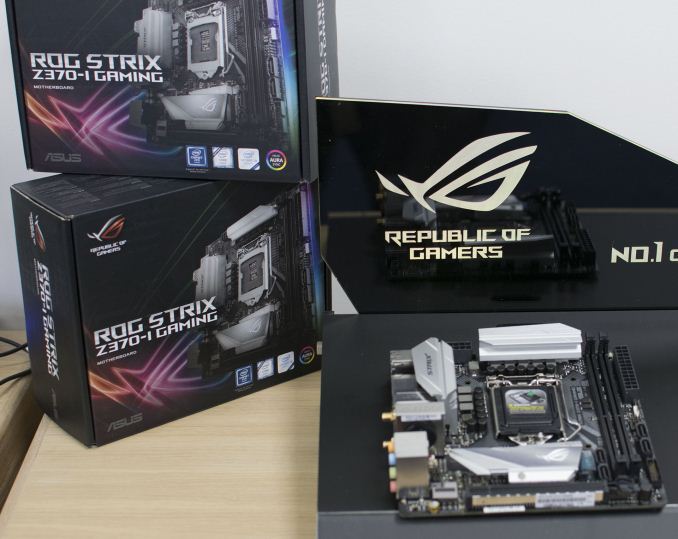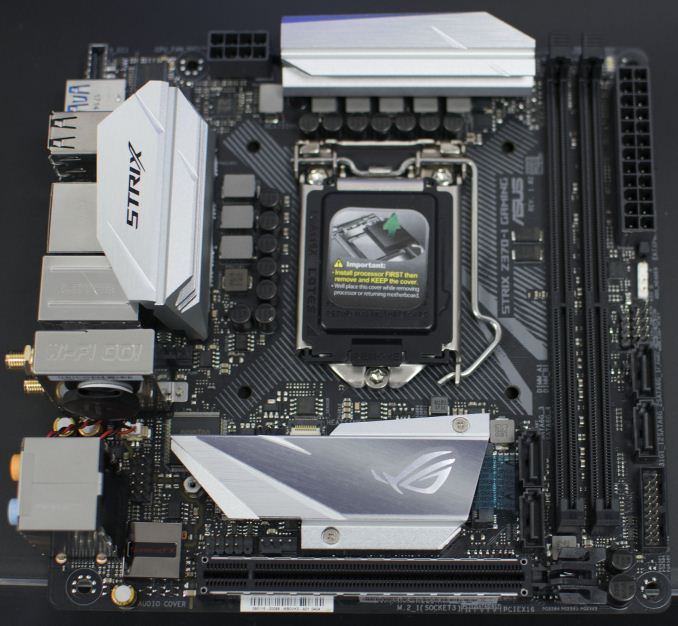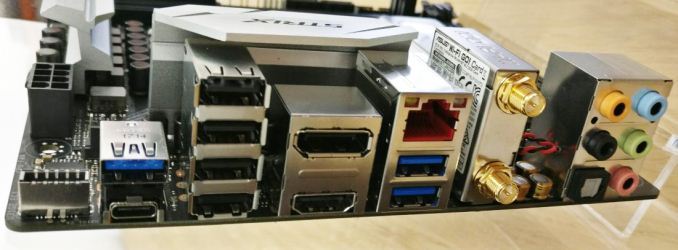Analyzing Z370 for Intel's 8th Generation Coffee Lake: A Quick Look at 50+ Motherboards
by Ian Cutress, Anton Shilov, Joe Shields & Gavin Bonshor on October 20, 2017 2:00 PM ESTASUS ROG STRIX Z370-I Gaming
Having spoken to ASUS at a recent event, there are no current plans to release a new Maximus Impact ITX offering to the market on Z370, so users specifically looking for an ASUS option will have to make do with the Strix Z370-I Gaming for the smaller form factor.
With this being an ITX form factor motherboard, certain and very obvious sacrifices have been made to cut down the size, but aside from fewer PCIe slots and a couple of SATA ports having been removed, the feature set is certainly far from small. The Z370-I has a single full-length PCIe 3.0 x16 slot which features the SafeSlot reinforcement, and in design terms, it is very similar to the Z370-E in styling and features new light silver metallic heat sinks.
Only two full-size memory slots can realistically fit onto an ITX form factor board - in recent years we have seen motherboard vendors push one memory slot per channel (1 DPC) designs on ATX boards as they can afford better performance through higher frequency margins, and ITX boards can get these benefits naturally: ASUS have rated the Strix Z370-I Gaming highly with support for up to DDR4-4333, memory controller on the CPU depending.
With storage, the Z370-I Gaming has four SATA ports, which are set upright out of the board with a pair on the edge outside of the DRAM and the second pair just inside, with this latter group potentially affected by large memory heatsinks, a large GPU cooler backplate, or a large CPU cooler. There is also two M.2 PCIe 3.0 x4 slots, one of which is neatly tucked under the main silver heat sink, and the other is placed on the rear of the board.
For audio, the Strix Z370-I Gaming like all the other Strix and Maximus Z370 boards utilizes the Realtek ALC1220 codec. The audio PCB segment uses gold Nichon Japanese audio capacitors, and the codec features a small EMI shield to protect from interference. Video support on the rear comes via DisplayPort and HDMI, and networking from an Intel I219-V gigabit Ethernet controller and an 802.11ac WiFi module.
The rear IO board has three USB 3.1 10 Gbps Type-A ports, a Type-C port, and four USB 2.0 Type-A ports. Headers on the board offer another USB 3.1 10Gbps port and four USB 2.0 ports. The small ITX form factor isn’t known for being rich in the way of fan headers, and on this board there are two regular 4-pin fan headers, a single header dedicated to AIO CPU coolers. There is also a single thermal sensor header.
It might be strange to think that ASUS ROG has started omitting Maximus Impact boards from the range - it would mean that ASUS has shifted focus away from high-performance ITX motherboards. The Impact boards were always over-engineered, which might be related to the delay, or ASUS might be saving it depending on market potential.













83 Comments
View All Comments
carldon - Saturday, October 21, 2017 - link
Excellent summary and table in the last page. Good work!!!imaheadcase - Saturday, October 21, 2017 - link
I got a few questions:1. Why do they put USB 2.0 ports if USB 3.0 is backward compatible anyways? Why not just all USB 3.0 ports..it can't be price.
2. Why do they have such a vary in memory timings? For %99 of people memory timings are not really a big deal right? Maybe in old PC days it was.
3. Mini-ITX vs Micro-ITX..isn't it silly both exist in first place? Any reason for this..the diminsions are really close to the same. In fact, most Micro-ITX is simply removing lots of stuff from mobo that you really want to begin with.
lordsutch - Saturday, October 21, 2017 - link
I'd imagine they want to offer as many ports as they can without taking away too many PCIe lanes. The other option would be to embed a USB 3.x switch (or a PCIe switch) but of course now each port wouldn't simultaneously be able to operate at peak speed and 3.x switches are probably more expensive than USB 2 controllers.imaheadcase - Sunday, October 22, 2017 - link
Ahh didn't think about that aspect.DanNeely - Saturday, October 21, 2017 - link
Some USB audio and 2.4ghz wifi/bluetooth devices have had interference problems in 3.0 sockets. Dunno if they're fixed on new hardware (supposedly onboard hubs were a lot worse than chipset ports in this regard so room for QC to make it better); but even if they are there's going to be problems with once burned customers not trusting them.As pointed out elsewhere USB3 competes with PCIe lanes/SATA ports on the southbridge. Especially on full ATX boards if you go to max out the number of PCIe lanes to expansion slots and m.2 ports in addition to the lanes used on board for networking and audio you can get down to only a half dozen or so 3.0 lanes left from the chipset; but still able to hit 14 USB ports total by going USB2 with the rest.
People using older OSes (Windows 7 says hi) can't use USB3 ports to install the OS without jumping through a lot of hoops (the OS sees them as not USB2 and can't talk to them).
If any board size is at risk of going away it's probably full ATX; although for enthusiast sales I suspect it'll hold on better than mini ATX due to bigger is better irrationality.
MiniITX still has a decent capability gap vs mini ATX; but it's much smaller than it was a half dozen years ago when it only made sense if you were making a tiny box and were willing to accept major performance compromises to do so. Now as Mini ITX's capability continues to goes up and the need for expansion cards other than a single GPU goes down it's eating into an increasing chunk of Mini ATX's marketshare.
On the high side mainstream chips don't really have enough PCIe lanes to make good use of the extra 3 cards of space possible on the bigger boards/ Meanwhile multi-GPU gaming - the main reason an enthusiast would need a full size mobo is steadily going away (fewer games supporting it each year, no support for 3/4way at all in the newest cards from either company); and unless you need 2 GPUs + something else or extra space around the CPU for crazy OCing Mini ATX does almost everything that could be needed.
MadAd - Sunday, October 22, 2017 - link
> If any board size is at risk of going away it's probably full ATX; although for enthusiast sales I suspect it'll hold on better than mini ATX due to bigger is better irrationality.Irrationality indeed. I would have thought by now instead of a measly 5 mATX choices out of 50+ that it would be instead maybe 5 fullsize ATX with the main battleground being the two slot mATX market.
Its just laziness on the manufacturers side, with nobody steering the market to innovate on size. Theres nobody driving form factors, the CPU companies are present on all form factors so they dont need to drive change, the board partners are all set in their ways just slapping new images on mildly reworked designs so they dont have any need to innovate, weve seen video card manufacturers can shrink designs to better fit smaller factors but we still get chunky easy to produce cards for mainstream use as retooling would be an added cost, its just rolling train of new but nothing new generation after generation.
PC design is falling into mediocrity and I just wish the main players (intel+amd/board partners/nvidia+amd) would all get together to drive SFX/ITX and force retire ATX to the strictly enthusiast market, and maybe appeal to a more contemporary home user community (rather than just gamers which is where the marketing all seems to be these days) again too.
Liltorp - Saturday, October 21, 2017 - link
It is really true that the MSI PC Pro has a legacy PCI connector? I could use this for my TV tuner. But I thought PCI was not supported by newer boatds/CPU`s?Morawka - Saturday, October 21, 2017 - link
Has anyone noticed how cheap these new Z370 motherboards are? Most are under $180 and there are several sub $130.IGTrading - Sunday, October 22, 2017 - link
Tell this to the guys that already spent money on non-Z370 just a few months ago.Intel is already screwing them.
It would have been funny to sell a 250 USD motherboard to a 7700K buyer just last month, telling him his 250 USD are a good investment because of the good upgradeability.
Just 4 weeks later tell him: "Well ... Yeah ... About that upgrade ... It will cost you a minimum of 110 USD extra + the 360 USD for the new 8700 K.
775 was the last good & long lived platform from Intel.
edzieba - Sunday, October 22, 2017 - link
If people brought Z370 boards expecting them to support an additional CPU generation, they did it in spite of every Intel CPU release for the last decade: two CPU gens socket generation. There's no counter to ignoring the past.